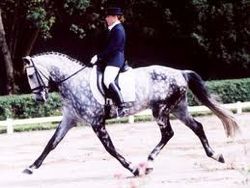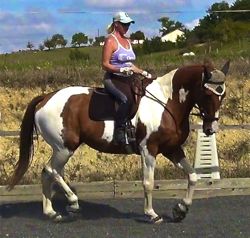Monday
Being a Steward, A Note From My Owner
I read something today that really stuck. It was parelleling horse ownership to being a steward. As I read it I began to form an image in my mind of myself as someone who is entrusted with the care of something very sacred. When you really sit down and think about it, horses are some of the most majestic and graceful creatures that God ever created.
I liked this concept so much I felt it was important to share. Horses don't get to make many choices without a human's hand in most of it. Sure, they can decide which patch of grass to share with a herdmate or where to roll in the mud, but they don't get much of a say in when or what they eat or how they spend their time in our care. It's up to us, the people who have these beautiful animals in our lives, to make sure we do right by them. They depend on us, their stewards.
Being a steward means being a guardian and ensuring proper care and well being while in our care, for whatever length of time that may be.
The next time you are with your horse I challenge you to look at things differently and view yourself as a steward.
Labels:
care,
guardian,
responsibility,
steward,
stewardship
A Great Article From Happy-Horse-Training.com
The Mechanism of Engagement
A good way to describe the phenomenon of the ring of engagement of horse and rider is to liken the horse to a bicycle. When riding a bike in gear, you are applying force to the pedals which engages the chain and turns the wheels. When a rider engages a horse they have to activate a similar cyclic system, except it is made of muscles and ligaments rather than cranks and levers.
One difference is that in riding a horse, the engine lies within the horse whereas it is the cyclist who powers the bike. This, in addition to the fact that the horses is not already straight and ready to carry a rider like a bike is, makes riding a horse such a complicated enterprise. Thinking about the difference between riding a bike in gear and freewheeling along, however, does help to define the sensation of engagement, as well as illustrating that engaging a horse is a real, physical phenomenon. Unfortunately, because it requires accurate posture and weight positioning of the rider - itself the result of a specific gymnastic development, many people never experience it when they ride.
Just as a bicycle is nicer to ride when it is prepared properly i.e. pumping up the tires and oiling the mechanism, a horse benefits hugely from the right kind of preparation before riding. This involves tuning the cardiovascular system to an extent, but most importantly strengthening the musculoskeletal system for engagement . This is so that the rider's weight does not trigger the hollowing reflex in the horses back, as well as improving the horse's ability to rebalance themselves before they are unbalanced further by the rider.
The actual process of engaging a horse is powered by the leg in the same way as a cyclist pushes the pedals. In the rider's case it is a stimulation as well as a balancing and softening effect, because the true power comes from the horse, and it must be managed as well as encouraged in each moment.
 Riding with no or little leg contact is the equivalent of freewheeling. Although motion continues, the connection to the engagement mechanism is interrupted, so there is no real control of the horse's body, other than steering his mouth which can hardly be described as control. Having 'traction-on' is the key to an enjoyable riding experience (photo, below). As for modifying the speed, the brakes on a bike influence the wheels. The rider uses the seat aids, which are a combination of postural balance, weight aids and upper leg aids to influence the power coming through the horses body from his engine, mainly in the haunches.
Riding with no or little leg contact is the equivalent of freewheeling. Although motion continues, the connection to the engagement mechanism is interrupted, so there is no real control of the horse's body, other than steering his mouth which can hardly be described as control. Having 'traction-on' is the key to an enjoyable riding experience (photo, below). As for modifying the speed, the brakes on a bike influence the wheels. The rider uses the seat aids, which are a combination of postural balance, weight aids and upper leg aids to influence the power coming through the horses body from his engine, mainly in the haunches. 
Looking at it in this way, all of the correct aiding from a rider, which generates, maintains and controls engagement accesses the horse directly where he engages, in his muscular ring (see HHT page 'What does 'on the bit' really mean?'). This is because this is exactly where the rider touches the horse which their body. Direct physical connection is the secret to becoming 'one with your horse'.
Read more about engagement here.
Subscribe to:
Comments (Atom)

